
Hal and Kyle Griffith, the family that brought us the Great Wheel, and Matt Roewe, the architect that proposed the Capitol Hill gondola, unveiled plans for a new waterfront gondola system this Tuesday. The system will consist of three stations—one at Freeway Park next to the convention center, one at Waterfront Park, and an uphill-only station on Union between 1st and 2nd. The gondola will be paid for using private funds, and the goal is to have it ready for operation within weeks of the Viaduct being removed. It will have a capacity of 1,800 people per hour per direction, will have a travel time of 5 minutes end-to-end, with a vehicle frequency of 16 seconds. Cars will carry eight passengers each, and will have room for wheelchairs, strollers, or bikes. They will travel on 8 columns at a height of 40-50 feet off the ground: enough to easily clear trolley wire. The stations will be set up above the roadway and will be accessed by elevators and stairs.

With the viaduct coming down and the seawall being rebuilt, the waterfront will be a complete construction zone for years. There is a risk that this construction will drive away customers and locally owned unique businesses would go bankrupt. If that happens when the waterfront is finished we may end up with far less character and national chains.
Just like the Great Wheel, the purpose of the gondola is to pull people to the waterfront. These would be conventioneers, but also tourists. The massive Freeway Park parking structure is currently closed on weekends because there’s little demand. But connect that with the waterfront and you get an easy on/off the freeway trip to downtown and the water. Less traffic driving through the city, and easier tourist access. You couldn’t do this with buses—there’s a cliff in the way, the route would be ugly, and it would be slow and infrequent. Although it seems like a reasonable distance to walk, tourists don’t tend to walk this far—parking is difficult to find near the waterfront on summer weekends, yet just half a mile away lots are empty. Plus there’s a significant elevation change as you approach the waterfront. Considering this as just a tourist line, the effect on the city is positive: a bit less traffic downtown and saving businesses on the waterfront.
Kyle Griffith has talked about 2-tier pricing and Orca integration, and has looked into options for extending the line up First Hill. Now that gets interesting. The downtown node happens to be a bit over 1 block from the light rail tunnel entrance, and 1/2 block from the future streetcar. The waterfront station is less than 1/4 mile from the Coleman ferry terminal. Plus Freeway Park is so empty it’s dangerous, and this could activate it both as a station in this design and as a transfer node if the First Hill line is built. As transit projects go this won’t have a huge impact—a pedestrian will probably only save 10 minutes between the waterfront and the convention center. But for families, the elderly, suburban drivers, and even some ferry commuters this has the potential of being a useful piece of the transit system. And it won’t cost taxpayers a dime.


